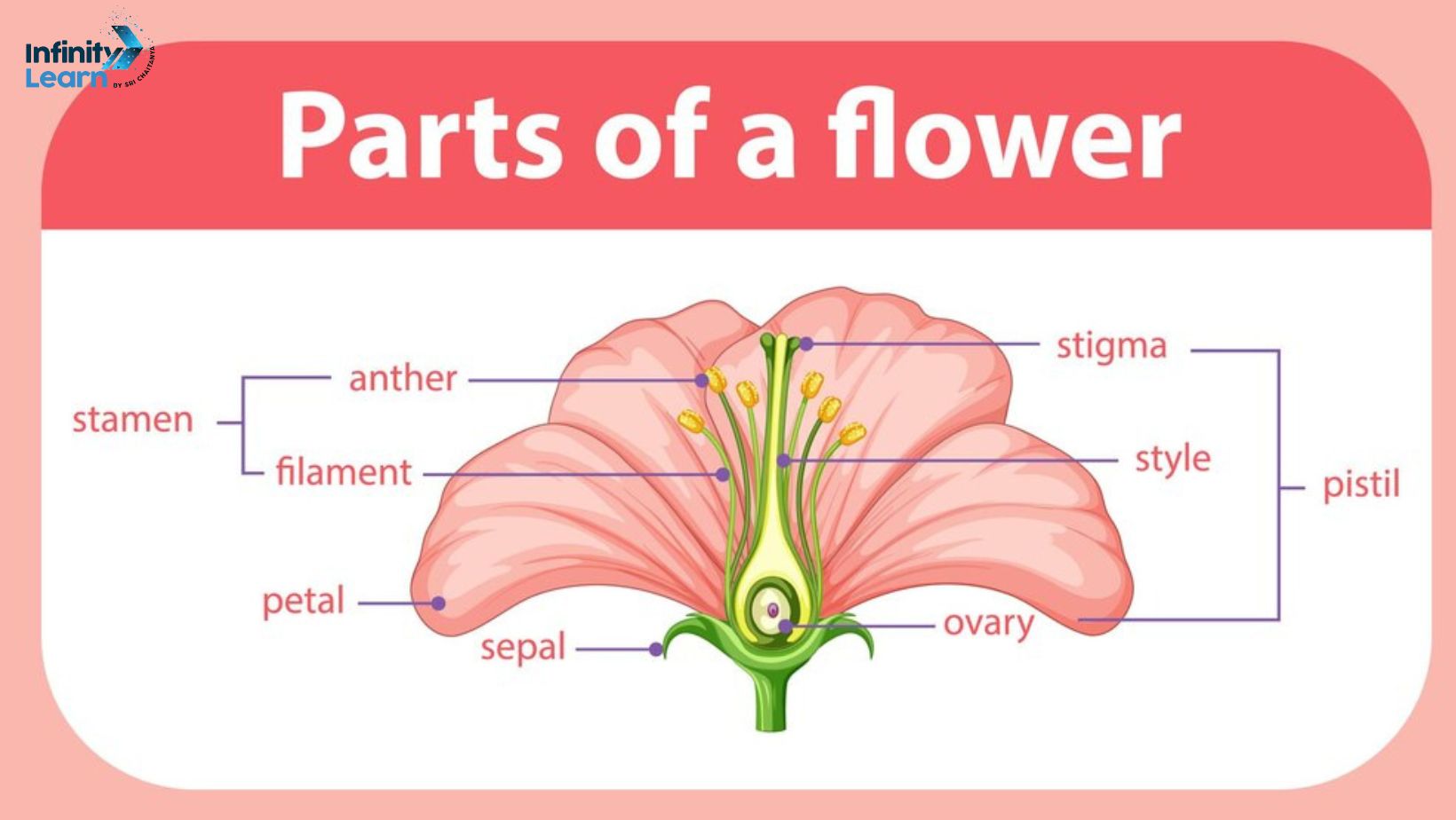Table of Contents
The reproductive part of any plant is flower. Flowers are also the food for some living organisms as they are a rich source of nectar. Flowers can either be complete or incomplete.
Complete flower: A flower which contains sepals, petals, stamen and pistils is called a complete flower. A complete flower consists of both vegetative part and reproductive parts.
Incomplete flower: A flower which does not have one or more than one of the above parts, they are called incomplete flowers.
Parts of a flower
A flower consists of four main parts. These are sepals, petals, carpels and stamens. A flower can be female, male or it can be both. If a flower has both carpel and stamens, they are bisexual. If a flower consists of either carpel or stamen, they are unisexual.
Let’s discuss the different parts of flowers:

Vegetative Parts of a Flower
The vegetative parts of a flower are petals and sepals.
- Petals: Petals are of bright colour. Petals attract pollinators like bees, insects and birds. Each plant has different kinds of petals. Some can be colourful while some petals can be of pale colour.
- Sepals: The green-coloured path under the petals is sepals. It is a leaf-like structure. Calyx is a group of sepals. Its main function is to protect the flowers during the bud stage.
Reproductive Parts of a Flower
The stamen and pistil are the reproductive parts of a flower.
- Stamen: The male part of a flower is Stamen. It consists of pollen grains. Stamen is also known as Androecium. There are two parts of the stamen: anther and filament.
The function of another is to store and produce pollen. It is yellowish in colour and has a sac-like structure.
Filament supports anther. Its structure is like a thread.
- Pistil:The female part of a flower is the pistil. It is the innermost part of a flower. Pistil consists of three parts:
- Stigma
- Style
- Ovary
- Stigma is the topmost part of carpels.
- The style connects the stigma and ovary and has a long tube-like structure.
- Ovules are stored in an ovary. It is the ductless reproductive gland. The ovary is the part of the plant where seed formation takes place.
Whorls
The radial arrangement of a flower is possible with only four whorls present in a flower. There is a circular section present in the flower having a common centre. The four whorls are discussed below:
- Calyx: Calyx is the outermost whorl. It consists of sepals and leaves which are present at the base of a flower. The main function of the calyx is to protect the flower during the bud stage. In some flowers, calyx may be absent or in some, can be similar to leaves.
- Corolla: Corolla consists of petals. The function is to attract pollinators and also to protect the reproductive part of a flower.
- Stamens: Stamen is the male part of the flower. It consists of a filament and anther. Stamen consists of pollen grains.
- Carpels: It is present in the centre. Carpels consist of a pistil, which is the female part of a flower. The pistil consists of a stigma, style and ovary. There are ovules present in the ovary. After fertilisation, the ovary converts into fruits to keep the seed.
Functions of a Flower
The functions of a flower are discussed below:
- One of the main functions of a flower is reproduction, as it contains reproductive parts of the plant.
- It forms seeds and fruits after fertilisation.
- Flowers attract insects for pollination.
- Cultivation of flowers is done by human beings as these are required for many occasions.
Pollination
Pollination is the process in which pollen is transferred from anther to stigma. There are different mediums through which pollination can occur. In most of the flowers, male and female parts are present. They are called bisexual flowers. In flowers, if one of the parts is present, they are called unisexual flowers.
There are different types of pollination.
- Autogamy: If the pollination takes place between the stigma and anther of the same flower, it is known as autogamy. In this case, there are two types of flowers: Chasmogamous and cleistogamous.
- Viola, oxalis, hibiscus, and beans are chasmogamous flowers. Their anthers and stigma are exposed. Cross-pollination can also take place in these flowers.
- Groundnut peas are examples of cleistogamous flowers. Their anther and stigma are not exposed, so cross-pollination cannot take place in these flowers.
- Geitonogamy: In this type of pollination, pollen is transferred from the anther of one Flower to the stigma of another. This pollination takes place in the same type of plant. Example: Maize.
-
Flower, the characteristic reproductive structure of angiosperms. Flowers facilitate the reproduction of angiosperm species through the production of seed and the formation of fruit. Learn about the various parts of a flower, floral types, and pollination with this article.
Agents of Pollination
- Abiotic agents: Agents like wind and water are abiotic agents. They transfer pollen grains. Anemophily is the wind pollination. It happens when pollen grains are light in weight and are produced in many numbers. Examples are rice, wheat, barley, and corn. In all these examples, anthers are exposed, and the stigma has a down surface to catch the pollen grains. If the pollination occurs through water, it is called hydrophily. Example: Vallisneria and hydrilla.
- Biotic agents: Pollinating agents like insects, animals, and birds are biotic agents. The flowers pollinated through these agents are very attractive and vibrant.
Some of the pollinating agents are bees, ants, butterflies, sunbirds, hummingbirds, lizards, etc.
Flower FAQs
Write some important parts of a flower.
Petals, sepals, stamen, pistil.
How does reproduction in flowers take place?
Pollination is the process through which reproduction occurs in flowers.
Write three uses of flowers.
Food production Preparation of dyes Medicine production









